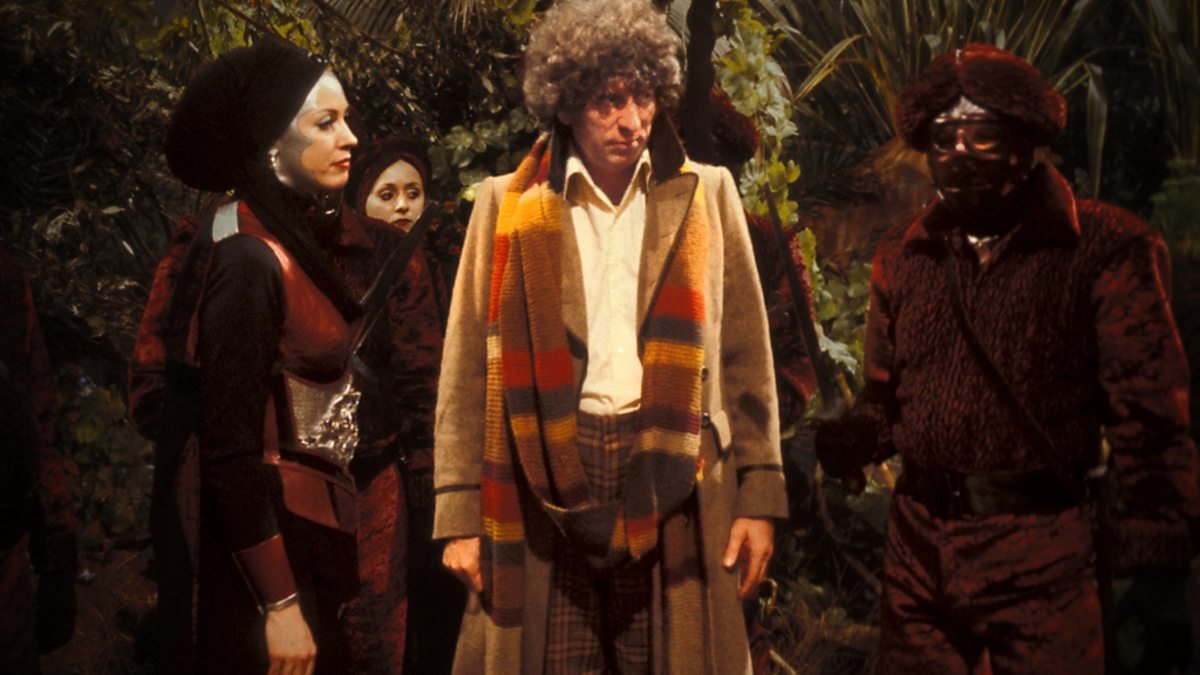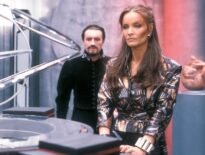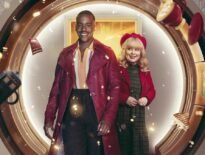Back in the 1970s, before the internet, before Kasterborous, before The Doctor Who Companion itself – there were fanzines like Fendahl, sold for 30p an issue, photocopied and posted across the world.
Edited by Simon and Frank Danes, Fendahl ran from 1978 to 1981. Reviews and views of the new episodes were a staple of the fanzine; back in the day, there was no internet and no way comments could be posted, so you had to post comments in a letter.
In this article, we reprint some of those original reviews and letters.
These have been slightly edited to avoid repetition and infelicities of style (we were young then and had black hair. Ah me…). Many thanks to the original writers and I hope that this selection does their views justice. Some of them I haven’t seen or heard of for over 40 years…
Let’s time travel back to the days when Graham Williams was producer, Tom Baker was the Doctor, K9 was a new companion, and people worried about Doctor Who being cancelled…
The Ribos Operation
Review from a 1978 edition of Fendahl
The Ribos Operation could quite easily have been for a TV series other than Doctor Who. Ribos was too much like medieval Earth for my liking… I don’t like stories with humans at all. I’d like to see more monsters. The shrivenzale could count as a monster, but being badly made, and roaring like a lion, I wouldn’t count it as such. Bad acting was present in abundance, which surprised me as the cast had a few guest names in it. The only good actor was Iain Cuthbertson, plus Tom Baker, naturally.
The Seeker, who could sniff out crooks, was never properly explained, although I expect she was able to home in on brainwaves; i.e., she was telepathic.
The story had three good points: it was just about believable; it had a good, mysterious atmosphere; I like the concept of the Key.
Summing up: Doctor Who is not as imaginative as it used to be, especially because of K9. It has always been said that the Doctor is compassionate but he lets K9 kill people without caring tuppence about it.
Matt Hayden
The Pirate Planet
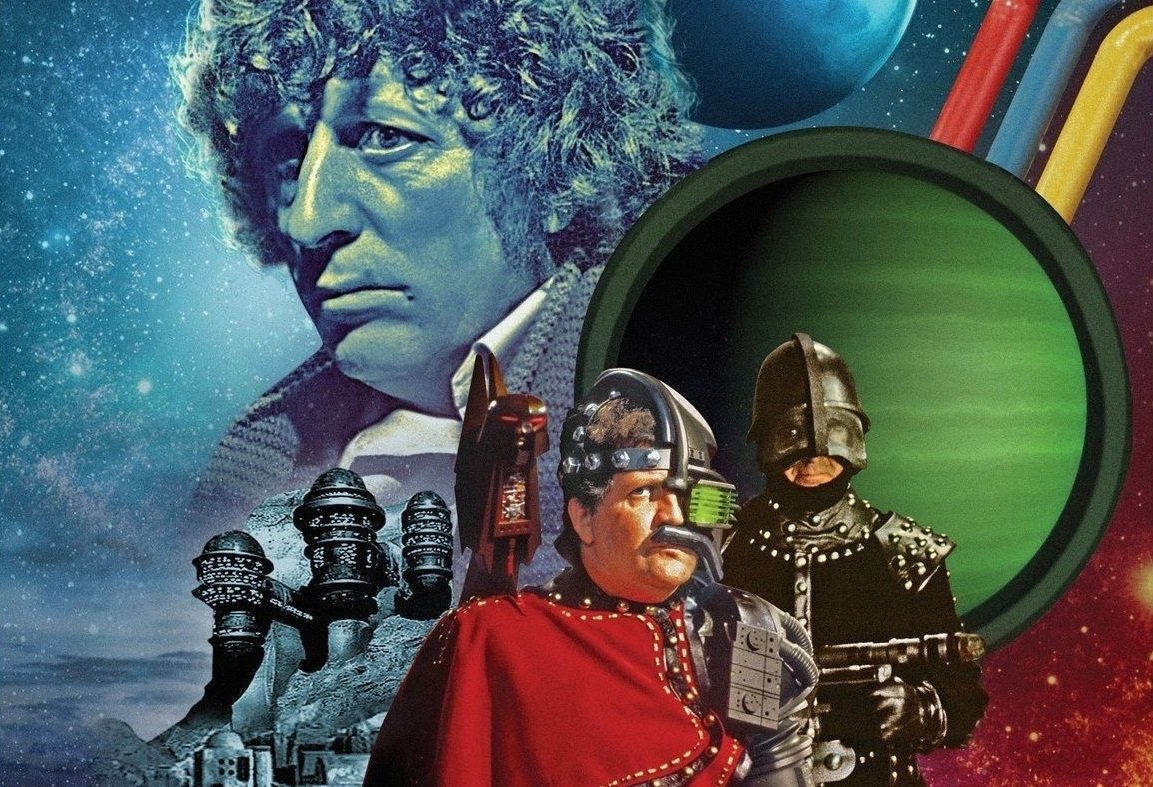
Review from a 1978 edition of Fendahl
The second story of the sixteenth season gets underway. So far, I think both of these stories have been better than last season’s. The first episode of The Pirate Planet was a little disappointing as the appearance of the Mentiads was somewhat corny as was their calling each other “brothers” throughout the story, practically in every sentence. The Captain was a good start to Part One and the effects, costumes, and sets were fabulous, and I appreciated them greatly, even though I watch Doctor Who in dull shades of black and white. Zanak society was well done: the people were like puppets, accepting almost everything as another piece of the Captain’s great goodness, even having Mula’s father shot to “save him from the Mentiads”. Romana seems better than Leela as a companion. I loved the way that the Captain was a parody of a pirate: robot parrot, false arm, walking the plank, and the eye patch.
Later, we learn that, in attempting to destroy Zanak, the TARDIS may blow itself to pieces. This is an inconsistency because it has been stated many times in the past that the TARDIS is indestructible. However, I don’t worry about continuity too much, although I do recognise some of the errors.
To summarise: The Pirate Planet is the best Doctor Who story since The Robots of Death. The programme is definitely on the way up again. This story must join the ranks of classics including Genesis of the Daleks, Robot, Frontier in Space, and so on. I’m glad to see comedy took a back seat in this story. It was present, but only in moderation. The Sun Makers’ comedy element went too far, giving a show that was very like a pantomime.
Simon Danes
Season 16 Overview (A 1979 edition of Fendahl)
To my mind, this was undoubtedly Tom Baker’s best season. That, however, is not saying much, as Tom’s time as the Doctor has been plagued with problems and violent changes. Over the past few years, each season has had fans of the show on the edge of their seats, not with excitement, but with worry. Monsters – so popular – were phased out and the TARDIS interior was changed on a whim. Companions became outrageously gimmicky with the advent of Leela and K9 and whole seasons seemed to be haphazardly flung together. What we needed was a return to sanity and that is certainly what the sixteenth season was…
The Ribos Operation and The Pirate Planet were the highlights of the season… The Androids of Tara and The Power of Kroll, though colourful in parts, lacked form. Androids could have been three parts, not four, and consisted mostly of meaningless chases and a tedious sword fight between the Doctor and Grendel. Character-wise, Kroll was the worst: Robert Holmes seemed to be overwhelmed by the idea of a giant squid and, while fascinated with the concept, failed to notice that there were other characters in the story. Consequently, colonists and Swampies alike acted as if they were cardboard cut-outs.

The Stones of Blood and The Armageddon Factor were just as disappointing. Stones was a rehash of Image of the Fendahl. The Armageddon Factor was a typical six-parter in that Parts Three, Four, and Five consisted of aimless running about in corridors. The ultimate failure to explain how the cosmic balance was restored spoilt the entire season.
Romana was (or rather, is) an interesting, useful companion and K9 fitted in a lot better this season. The running theme was a good idea and, on the whole, was well executed, but to keep people waiting for the ultimate confrontation between good and evil in the universe and then just to pass it off in a couple of speeches is not only dramatically bad but an irritating waste of everybody’s time.
Tim Robins
Letter from Pat Ottewell, Derby
I disagree with Owen Tudor, who said The Power of Kroll was let down by its actors. The actors concerned have proved themselves as very competent in the past – Philip Madoc in particular. They were let down by the poor script. And to the Beeb: for repeating The Pirate Planet in the summer – 10/10. For repeating The Androids of Tara – no comment!
Destiny of the Daleks
Reviews and comments from 1979 editions of Fendahl
TV Review:
The very first scene was more than a little stupid. Time Lords can’t regenerate at will, or so far it’s never been stated that they can. Five regenerations down the drain for Romana. Amazing that the clothes regenerated as well, isn’t it? Still, it must have been hard for the production team to write out Mary Tamm without us getting a glimpse of her.
The Movellan spaceship: cheapo cheapo, who spotted the control panels from [Saturday morning BBC 1 children’s show] Multi Coloured Swap Shop, the doors from The Invisible Enemy? And spot the CSO [chromakey] effect when the ship was flying. It amused me that the tabloid papers made so much of Suzanne Danielle’s casting when she had only about ten lines to say… and she delivered them badly.
Part Two was probably the best episode of the story because of the emphasis placed on the Daleks. I did notice, though, that one of the Daleks had a particularly human voice [probably David Gooderson’s, giving a first performance as a Dalek], which sounded rather silly. The Dalek machines themselves were in an appalling condition, as anyone who saw them at [DWAS convention] Panopticon will know. It’s sad that the most famous monsters in science fiction were so tatty. One had a broken eye stalk and black rims around its lights; one was a Genesis type unpainted; one was in reasonable condition; and the fourth was simply falling to bits. Various sections lifted up and clonked down when the operator was being careless. Also, squeaky wheels. It would have been a good idea to have repainted them well, and possibly redesign them more than to the extent of slapping a spot between the sucker and gun.
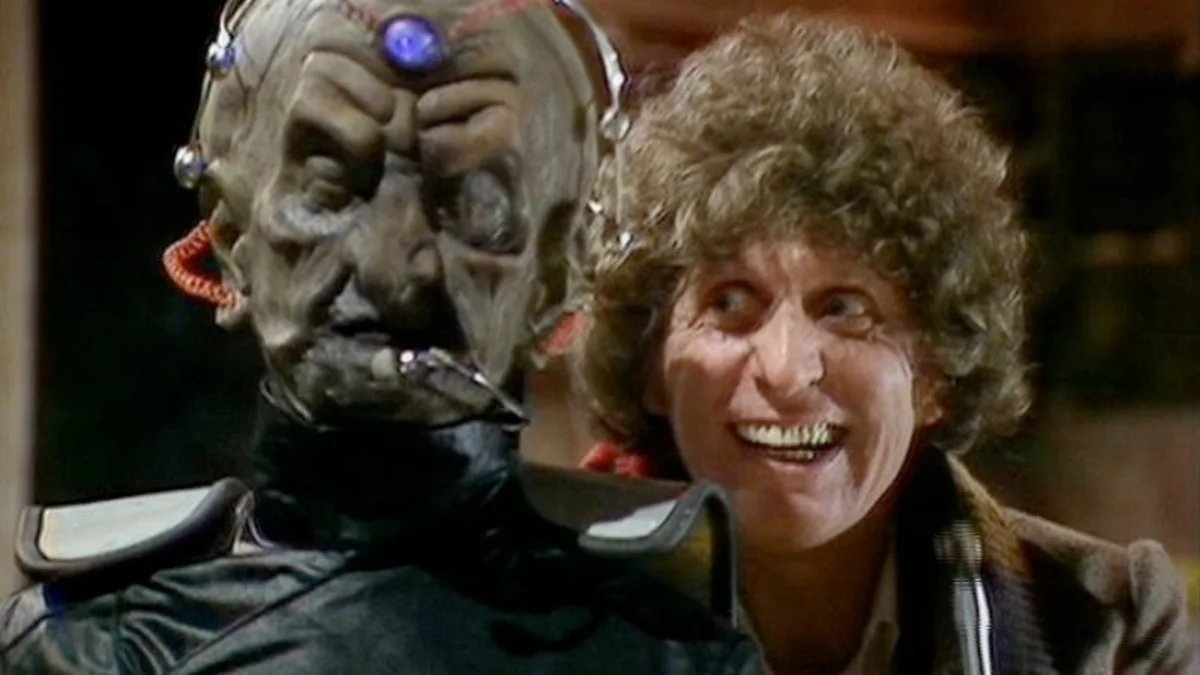
The concentric circle effect for the Daleks’ point of view was great but this would lead to limited vision, as did a similar effect in Death to the Daleks. A fish-eye lens would probably be more practical.
Bringing back Davros was a bit far fetched. I had a hard time suspending my disbelief as David Gooderson bounced up and down in his chair, with his voice not even vaguely electronic. David also seemed a lot smaller than Michael Wisher, viz the wobbly mask, and the shoulder pads that were three inches above where they should have been. He came over a lot better in Part Four but was just not as powerful or believable as his Genesis counterpart. Still, David gave a reasonable performance as changing an actor is a tricky job and sometimes doesn’t come off (as with Brian Croucher as Travis 2 in Blake’s 7).
Part Four. What a climax! One fault was the scene where Davros ordered his creations to destroy the spaceship. Looking carefully, the dummy Daleks were very obvious: they just looked completely unfinished. The one that stood behind Davros when the “real” [i.e. moving] Daleks had departed was particularly bad.
One very major error of continuity I just couldn’t swallow: Daleks aren’t robots. The idea that they were was hinted at throughout the story, which could have been ignored until Davros said, “two robot races locked in conflict”. It seems incredible that Terry Nation forgot the origins of his most famous creations.
Exterminate! Well done all concerned on a first rate story. And Part One was watched [in the UK on first broadcast] by 15 million people: number 18 in the viewing charts.
Frank Danes, aged 13 ¾
Letter from David McGarva, Worcestershire
Terry Nation was told to write a story to resurrect Davros (a stupid thing to do in the first place) and so he needed a reason why his creations, the Daleks, would come back to their home planet and unearth the insane scientist from the Kaled city. This is why Nation developed a theme where the Daleks had become virtually computers, totally logical in their thinking. They had reached a stalemate with the Movellans and wanted Davros to reprogram their battle computers to give them a random element which would fox the Movellans and give them victory.
So our lovely old insane, suicidal, irrational Daleks have become unoriginal mobile computers who can’t even reprogram their own battle computers. In other words, Nation has destroyed what made the Daleks unique: the ultimate creature contained within the ultimate war machine, a species with no soul or conscience and a desire to eliminate all other life forms. Still. At least the reason for bringing Davros back was a solid one.
Some other writer will have to re-establish the way the Daleks used to be depicted, perhaps by having the Doctor jump a time stream… there should be another Dalek story next season, where everything is cleared up, and perhaps Davros will be put to rest (not that I don’t like the evil old mutant).
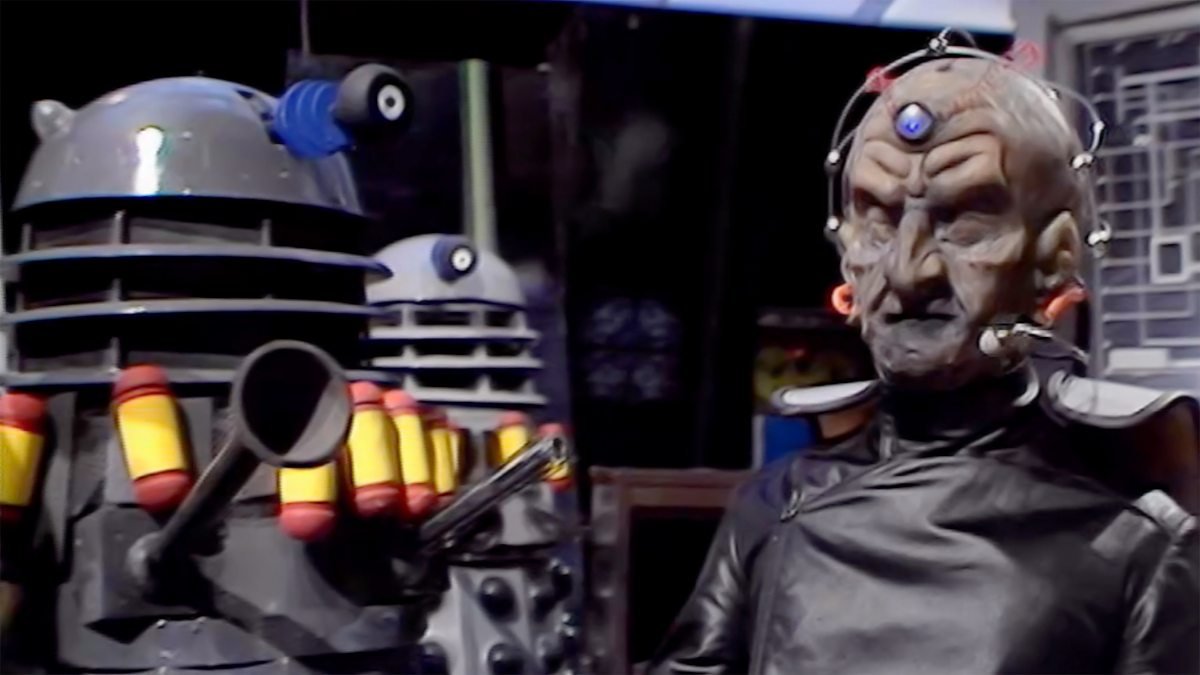
Although this story would have been more suited to the Cybermen, I was glad to see the Daleks back after a four year break, and the programme is improving generally.
Letter from Ronald G. Rowe, Moorpark, USA
I enjoyed the review of Destiny of the Daleks since it will undoubtedly be a long time before any sixteenth or seventeenth season shows reach the US. The reviews give us something to enjoy and look forward to as we wait for the day when Time Life decide to purchase more seasons of Doctor Who. US fans who are reading, keep writing to your local stations and Time Life. Don’t let them forget there’s a large following for the Doctor here.
Letter from David J Howe, Surbiton
The Destiny review was fine but… all the way through you were slanging it and at the end you said it was a classic. Does the inclusion of old monsters mean that a story is instantly a classic? Just look at The Invasion of Time – oh, do we have to?
Letter from Martin Wiggins, Oxford
As for Destiny, I don’t see how anyone could give it a good review. Episodes one and two were sub-standard Dalek Invasion of Earth, episode three was sub-standard Genesis, and as for episode four, that was just sub-standard. City of Death is ten times better… SF involving things like famous paintings, art galleries and profiteering is so much subtler than bug-eyed monsters. OK, so the Count is a bug-eyed monster but at least that’s not the major element in the story.
I’d like to add my contribution to the growing tirade against Mary Tamm. Quite simply, she regarded her contribution to the series as nothing above that contained in her contract, when there is a moral obligation that is higher than this. If you are involved in a long-running series, you do not cause it continuity problems. Look at earlier cases: Lis Sladen was persuaded to do a further eight episodes because of the problem of writing her out. Louise Jameson wanted to leave as soon as possible so she gave adequate notice.
Letter from Pat Ottewell, Derby
I do agree about Lalla Ward, she’s obviously a very competent actress and really puts Mary Tamm to shame. The return of the Daleks in Destiny was something most fans had been waiting and hoping for for years and, at last, that great day had arrived. I remember feeling quite nervous as I sat down to watch the first episode.
It had a reasonable start – apart, that is, from Romana’s regeneration. I liked the way the Daleks made their entrance. In fact this, and when they were interrogating Romana, constituted the main elements of excitement in the whole story, which overall was slow in pace and mediocre.
One fly in the ointment of Creature from the Pit is K9. Why didn’t the wolfweeds just finish him off? That new voice – ugh!
City of Death

Reviews and comments from 1979 editions of Fendahl
TV Review
When describing this, the second Doctor Who story of this season, the adjective “classic” comes to mind. Epic in scope, it spanned all of Earth’s past, yet kept within the bounds of limitations of budget. City proves more than ever the imagination of not only the writers but the production team, who had to deal with a spaceship, volcanic landscapes, Renaissance Italy, and present day Paris.
The first two scenes of episode one summed up the nature of Doctor Who without even trying. On a bizarre landscape, an alien spaceship lifts into the red sky; meanwhile, in 1979, the Doctor and Romana are sightseeing on the top of the Eiffel Tower. Terrific: the two landscapes jar in such a way as to leave the viewer in no doubt as to the programme he is watching. It’s Doctor Who at its best.
To determine the story’s “classic” nature, one has to look beyond the mere plot which at times, I’m afraid, left me cold. The menace from Earth’s past has been over-used, recently with Vivian Fey in The Stones of Blood, and in Image of the Fendahl, both of which stem from an all too obvious source: The Daemons. At the end of Part Two, my brother commented, “But nothing really happened,” and in many ways, I had to agree.
City of Death was a Doctor Who story which had its roots not in Tom Baker’s time but long before… the chase through time is a concept that hasn’t been properly used since The Chase, although watered down versions of it have been seen in The Time Warrior and The Time Monster.
Viewing figures for Part Two: 19.5 million, no. 17 in the viewing charts; for Part Four, 19.6 million, no 17 in the viewing charts. Viewing figures for Parts Two and Four unknown [at time of publication – 1979].
Letter from Mark Gillespie, Kent
City of Death was by far the best Doctor Who story of the season. Good camera work and brilliant music made this a Doctor Who classic. It did look as though Duggan was to be the Doctor’s next companion: it’s not all of the Doctor’s friends who get a ride in the TARDIS! The location filming certainly paid off and it’s worth doing again. Location filming like that is sadly missing from Doctor Who now.
Lastly, the production team’s tendency to send up Doctor Who. Just one or two little details make me wonder if they take their work seriously any more. Just small things, like John Cleese in City and the unusual noises coming from the TARDIS in episode two of Horns of Nimon. Even K9 was made to appear foolish by having to read Peter Rabbit to the Doctor. I mean, where’s it going to end?
The Creature from the Pit

Reviews and comments from 1979 editions of Fendahl
TV Review
Creature from the Pit was a very annoying story because it could have been so good, and it wasn’t. There were, however, some redeeming features, so the end product was mediocre as opposed to abysmal.
The new voice of K9 is heard reading Peter Rabbit, which is quite a witty idea. The next few minutes: oh no! Please! Haven’t we had enough of the Doctor’s past? So far this season, we’ve found out that the Doctor led the way out of the Minotaur’s maze, gave the jawbone of an ass to Samson, and wrote some of Hamlet.
The TARDIS lands in a good set, the jungle; interesting that it was on film at Elstree Studios instead of on videotape at TV Centre. I was surprised that Eileen Way, from An Unearthly Child, turned up and she gave a reasonable performance. The radio controlled wolfweeds were well done.
As the Doctor is captured, enter the female baddie. Adrastra. Yaaarg! How on earth such a great part went to Myra Frances I shall never know. It makes me weep to think of her massacring her lines, slurring the dialogue with melodramatic pauses. She did, however, do quite well with Erato/the Creature’s voice and the screamed “No!” at the end of episode three.
I was very disappointed with the polythene bluggle uggle. Haven’t we all had enough of big, green pulsating things – the Rutan, the Krynoid, and their ilk? Erato moved very unconvincingly and the probes were obviously hand operated. Chris Barry’s superb direction gave the mattress thing a bit more life but why did they stick with this design?
There were only a few continuity errors which I noticed. First, the Doctor can speak Tibetan: he did so with Cho-Je and the Abbot in Planet of the Spiders. Also, a mumbled line in Masque of Mandragora revealed that Time Lords can speak all languages. Secondly, the TARDIS is indestructible. This has been ignored recently – as in the zap Zanak scene in The Pirate Planet.
All in all, not a bad story, not good, and up to the standard of The Androids of Tara. Redeeming features were: K9’s new voice – I am a fan of John Leeson but feel that David Brierley does a better job as K9; Organon, the eccentric soothsayer; the sets, the special effects and generally good production. Even so, I don’t look forward to further stories by David Fisher: he churns out the most average plots down to the most dire trash. Why don’t the Doctor Who office try commissioning more writers?
Incidentally, after seeing Geoffrey Bayldon as Organon, say “aye” if you think he’d make a good Doctor. “Aye”, say I!
Simon Danes
[Simon’s review touches on a recurring idea in fandom in the late seventies. Older fans in particular, who grew up with William Hartnell and deplored both the show’s inflection towards comedy and Tom Baker’s increasingly antic performance, often cited Geoffrey Bayldon as a possible new Doctor – many said he reminded them so much of Hartnell.]
Letter from P. Wilson, County Durham

I didn’t agree with some of the comments about Creature from the Pit in your review. I enjoyed the story and thought Myra Wilson handled the part of Adrastra competently. I did notice that the Doctor really disliked Adrastra and hardly showed any pity at her being squashed by a Tithonian. In general, Doctor Who never seems to have the Doctor really hating the nasties, but this was an exception.
Letter from Tim Robins, Cardiff
I have a feeling that David Fisher will be chosen as the new script editor – and I hope he doesn’t accept the post. Although he has occasionally had moments of inspiration, for some reason his stories come across as very run-of-the-mill. Androids of Tara was simply dull and Creature from the Pit disjointed and heavily padded.
Letter from David McGarva, Worcestershire
I doubt if Time Lords can speak all languages: you only have to look at Carnival of Monsters [when the Doctor couldn’t understand Vorg’s carnival slang]. Also, everyone seems to be going on about Geoffrey Bayldon as the next Doctor and, although I admit he’s a good actor, I feel he is too old for the part. He couldn’t be involved in physical action as the last two Doctors were but he would be the more restrained, pacifist type of the first two incarnations.
Nightmare of Eden
Reviews and comments from 1980 editions of Fendahl
TV Review
I was sure that Nightmare of Eden was a story that would fall into the category of “enjoyable rubbish”. I thought Tryst was too like the Kerensky character from City of Death; the corridor set of the Empress was just so cheap; the passengers’ costumes were dustbin liners…
Dudley Simpson’s music grates: the jangle of horns which accompanied a very obvious model of the Empress at the beginning of episode one was dreadful. The Continual Event Transmuter, built by Tryst, was an obvious rip-off of the Scope from Carnival of Monsters. Tryst himself developed into an interesting character and he seemed a more capable person than Kerensky, so I wasn’t all that surprised when he turned out to be the villain. Captain Rigg was excellent: his callous, apathetic giggling [at the Mandrels’ slaughter of the passengers] was fabulous. And the idea of one ship materialising over the top of another in hyperspace was very clever.
At the end of Part One: “Right, Doctor,” says Rigg, and pulls away the hatch cut out by K9. And this glove puppet flops out, performs a few howls and waves its arms about. The Sun [British best-selling tabloid newspaper] had written that the Mandrels were truly frightening but surely we deserved better than a fur coat doing his arm exercises?

Into Eden in Part Three. Sadly, Stott was another badly acted character. One of the best moments was Rigg roaring with laughter at the sight of the Mandrels killing the passengers. “They’re only economy class. What’s all the fuss about?” His craving for vraxoin was very well acted. In Part Four, the Doctor’s disgust at the smugglers was well portrayed. A correspondent to TARDIS magazine recently wanted to know why the Doctor would never let the villains just be arrested but the sick despair of Tryst and Dymond, and the Doctor just telling Tryst to “go away” at his desperate pleading, was great. So was capturing the smugglers via the CET machine. Bob Baker has, for once, produced a story with strong morals, pointing to the callous mentality of drug smugglers who could kill their fellow humans for money.
Frank Danes aged 14 ¼
Letter from David McGarva, Worcestershire
I thought Nightmare of Eden was excellent and it is a pity that such a good story was let down by poor production. The special effects were quite good: although the actual collision of the spaceships was badly done, the shuttle was realistically operated, and the design of the two main ships were good. No Star Wars rip-offs in this programme! The story was saved by the main characters and another great BBC jungle set. The Mandrels were not exactly the most horrifying monsters I’ve ever seen; in fact, at the end of the story when the Doctor did his Pied Piper bit, one seemed so cuddly that my sister wanted one to go with her teddy bear!
Tim Robins’ review of Horns of Nimon summed up the whole season well. His words reinforced my fears that the programme could well end soon if things don’t improve.
Horns of Nimon
Reviews and comments from 1980 editions of Fendahl
TV Review
Quite honestly, it was difficult to enjoy Horns of Nimon with the knowledge that Shada had been scrapped. A cloud seemed to hang over the television screen, making the story seem more than a little dull. Otherwise, Horns seemed faultless in most respects. On the whole, the sets were very convincing and the costumes wonderfully weird. The plot used an interesting device: not having the TARDIS materialise until episode two but, once again, what happened to the Randomiser? This is the fourth story it hasn’t been used. Why, one asks, was it ever installed?
The Nimons themselves were a lot better than the Mandrels although their skinny bodies failed to make them look very impressive. However, apart from Destiny, this was the only true monster story of the whole season so one shouldn’t complain. The Nimon voices were effective; the first Nimon’s humped back kept separating from his body, so much so that I thought he was wearing a mask like Sutekh. Not until episode four was I convinced that it was meant to be his real body.
There was quite a lot to Horns of Nimon, some of it subtle, some of it not so subtle. Its origins in Theseus and the Minotaur were so obvious that this must again be classed as another Doctor Who tribute to the classical myths. I thought we had covered the Greek heroes’ adventures in Underworld which, despite its flawed production, was probably a better story. To be honest, I’m tired of such tributes. Tom Baker’s era is so full of them that I’m beginning to wonder if there aren’t any more original ideas left in the minds of the production team.

The other thing I’m very concerned about is the bad acting of most of the cast in the entire season. From Tyssan in Destiny of the Daleks to Soldeed in Nimon, we have been presented with a tremendous array of hammy acting, bad dialogue, and boring characters. The focus has been more and more on the Doctor and less and less on the other members of the cast. This could spell the death of Doctor Who. Whereas the action used to focus on many people, such as Ian and Barbara, who could break the story up to show many other events or to be involved in different, separate adventures, now everything hangs around the Doctor. Tom Baker is the hero: the only hero. Even in Pertwee’s days, we had UNIT as guest stars. All we have now is a robot dog and a female double of the Doctor, whose sole purpose seems to be to trade jokes with him (although Lalla has been a better companion than most). I cannot shake the feeling that Tom Baker will be the last Doctor and that the 1980s will see an end to Doctor Who.
In conclusion, Horns of Nimon was a good story but nothing really impressed me. In fact, apart from City of Death’s model work and sets, nothing this season has really impressed me. Despite last season’s faults – especially the pointless end to The Armageddon Factor – I found it to be very imaginative: in many ways, better than this season’s offerings. The Ribos Operation had a touch of class not often seen any more; The Pirate Planet was witty, with some brilliant concepts; Stones of Blood had a spot of long-lost horror; Androids of Tara had wonderful costumes and great location work; Power of Kroll had something but I forget what; and The Armageddon Factor had the Shadow and Drax. This season we’ve had, well, average Doctor Who fare with one exception.
Oh well. Back to another two more years of Tom Baker!
Tim Robins
Letter from Tim Munro, Huddersfield
Now that Graham Williams has gone, I think it’s safe to say that he was the worst, most careless producer of all. Every story he did had faults, with the exception of City of Death. I like K9 but Williams let authors do whatever they wanted with him. K9 would have been better if no one had been allowed to use him as a tank. I wish John Nathan-Turner and Barry Letts all the best with clearing up the muddled mess Williams has left behind.
Letter from Martin Wiggins, Lower Heyford
A small thing which irritated me was the fact that the script [of Horns of Nimon] forced the viewer to recognise its origins among the Theseus myths. The same was true of Underworld. I think it’s all right to do this borrowing, but to admit to it is inexcusable! This means that it is forcing the connection upon people who don’t want to recognise it, and so undermines the validity of the story, making it seem contrived and improbable. After all, the story did not depend dramatically on the fact that the audience recognised it as being somewhat derivative: indeed, that knowledge makes it hard to accept that this is something that actually happened. The same is true of the sillier noises that the TARDIS made [the boings from the rebooted console in episode one]. Doctor Who is primarily drama, not comedy or farce, and should be watched as such.
Letter from Ann Shelby, Oklahoma
As always, Fendahl’s letters pages make good reading, even though I don’t agree with some of the points about Tom Baker. It would seem many British fans are vehemently anti-Baker. Why is this? In my opinion, the man is a fantastic actor and does a terrific job as Dr Who.
Although I haven’t seen the sixteenth and seventeenth seasons, I must admit that I primarily sit down to watch Doctor Who to enjoy it. I don’t sit there analysing and criticising, but to see those special effects, those plots, and to watch Tom holding some of the weaker episodes together. In this, he does a great job, and this may be why the show has become so popular over here.
